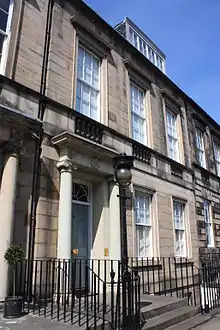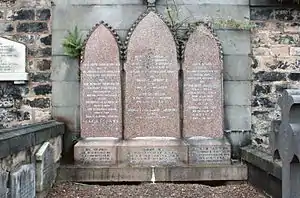Sir Alexander Christison
Sir Alexander Christison MD IMS, 2nd baronet of Moray Place (1828–1918), was part of the Edinburgh Christison medical dynasty. He was one of the first doctors to write on the medical benefits of cannabis.
He spent most of his working life in India. On return to Scotland he made major advances in achieving medical training for women.
Life


He was born on 26 August 1828 at 63 Northumberland Street in Edinburgh’s Second New Town[1] the son of Prof Robert Christison Professor of Medical Jurisprudence at Edinburgh University, and his wife, Henrietta Sophia Brown. The house was then a new house, designed by Robert Reid and William Sibbald.[2] He was named after his paternal grandfather, Prof Alexander Christison.
He was educated at Edinburgh Academy then studied Medicine at Edinburgh University. He gained his doctorate (MD) in 1850 with a thesis on the medical uses of cannabis. In 1851 he obtained a post as assistant surgeon to the Honourable East India Company and served with the 4th Sikh Infantry in the Second Anglo-Burmese War 1852/53 winning a campaign medal and clasp.[3]
He served with the 1st Cavalry 1855 to 1857 and accompanied Meade’s Horse regiment at the Mutinies of Gwalior and Agra in 1858, again receiving a campaign medal and clasp. He then gave medical support to the 18th Bengal Infantry. Late in 1858 he was made superintendent of vaccination and lecturer in surgery at Agra Medical School. He rose to be Principal of the school in 1865 and also took on a role as Principal of Agra Lunatic Asylum. Still connected to the military by 1879 he was Surgeon General for the entire North-West Provinces. [4]
He retired in 1882, following the death of his father, and his creation as 2nd baronet, and returned to Edinburgh. Here he joined his brother David Christison at 40 Moray Place, his father’s huge townhouse on the Moray Estate.[5] In Edinburgh he busied himself in various medical matters. Most notably he strived to reverse his father’s anti-female stance in the education of females and (more specifically) female doctors. He was President of the Scottish Association for the Medical Education of Women. He was also President of the Royal Victoria Hospital from its foundation in 1887. He ran several campaigns to reduce tuberculosis in Scotland.
He died at home 40 Moray Place in Edinburgh on 14 October 1918 aged 90.[6] He is buried with his family in New Calton Cemetery. The grave lies on a south-facing terrace, just west of the main north-south path, towards the centre.[7]
Family
He was married twice. Firstly to Jemima Anne (Annie) Cowley Brown (possibly a cousin) who died in 1876. Secondly he married Florence Elworthy (1851-1949) considerably his junior.[8] He had one son and two daughters by his first marriage, and two sons and three daughters by the second marriage.[9]
His youngest son, Lieutenant Frederick John Christison (b.1895) was killed on 4 December 1915 in the First World War while serving with the 10th battalion Argyll and Sutherland Highlanders.[10]
He was succeeded in the baronetcy by his oldest son Major Robert Alexander Christison of the Royal Garrison Artillery.
His cousin, Robert Christison died of tuberculosis in 1915.
References
- Edinburgh Post office Directory 1828
- Buildings of Scotland: Edinburgh by Gifford, McWilliam and Walker
- British Medical Journal 19 October 1918
- British Medical Journal 19 October 1918
- Edinburgh Post Office Directory 1885
- https://www.bayanne.info/Shetland/getperson.php?personID=I68119&tree=ID1
- https://www.gravestonephotos.com/public/namedetails.php?name=549710
- Christison Grave, New Calton Cemetery
- India in Edinburgh: 1750s to the Present by Roger Jeffrey
- https://www.cwgc.org/find/find-war-dead/results?lastName=Christison&war=1
| Baronetage of the United Kingdom | ||
|---|---|---|
| Preceded by Robert Christison |
Baronet (of Moray Place) 1882–1918 |
Succeeded by Robert Christison |